In today's competitive market, a steady stream of qualified leads is the lifeblood of any growing business. But with countless platforms promising to fill your pipeline, choosing the right software can feel overwhelming. This guide cuts through the noise. We've meticulously evaluated and compiled the definitive list of the best lead generation tools available, moving beyond generic feature lists to provide practical use cases, honest limitations, and implementation advice.
To truly unlock your growth, it's essential to begin with a clear understanding of the broader field of lead generation. This foundational knowledge will help you better evaluate which tools align with your specific goals. Our goal is to provide a comprehensive resource that helps Omaha-based businesses, e-commerce retailers, and tech startups make informed decisions without wading through marketing jargon.
Inside this guide, you will find a detailed analysis of each platform, including:
- Practical use-case scenarios to see how the tool functions in real-world situations.
- Honest assessments of potential limitations and who the tool is not for.
- Implementation tips to help you get started quickly and efficiently.
- Screenshots and direct links for every tool we review.
Whether you're focused on inbound capture with tools like HubSpot and OptinMonster, outbound prospecting using platforms such as ZoomInfo and Apollo.io, or enriching existing data, this resource will help you select the software that aligns with your strategy. Our analysis will empower you to streamline your workflow and, ultimately, drive measurable revenue growth. Let's explore the top solutions that can transform your sales pipeline.
1. HubSpot Marketing Hub
HubSpot Marketing Hub is an all-in-one platform that excels by tightly integrating powerful lead capture tools with a full-featured CRM. This eliminates the common challenge of syncing data between different marketing and sales systems. For businesses seeking a single source of truth for their customer data, HubSpot offers a compelling, unified solution.
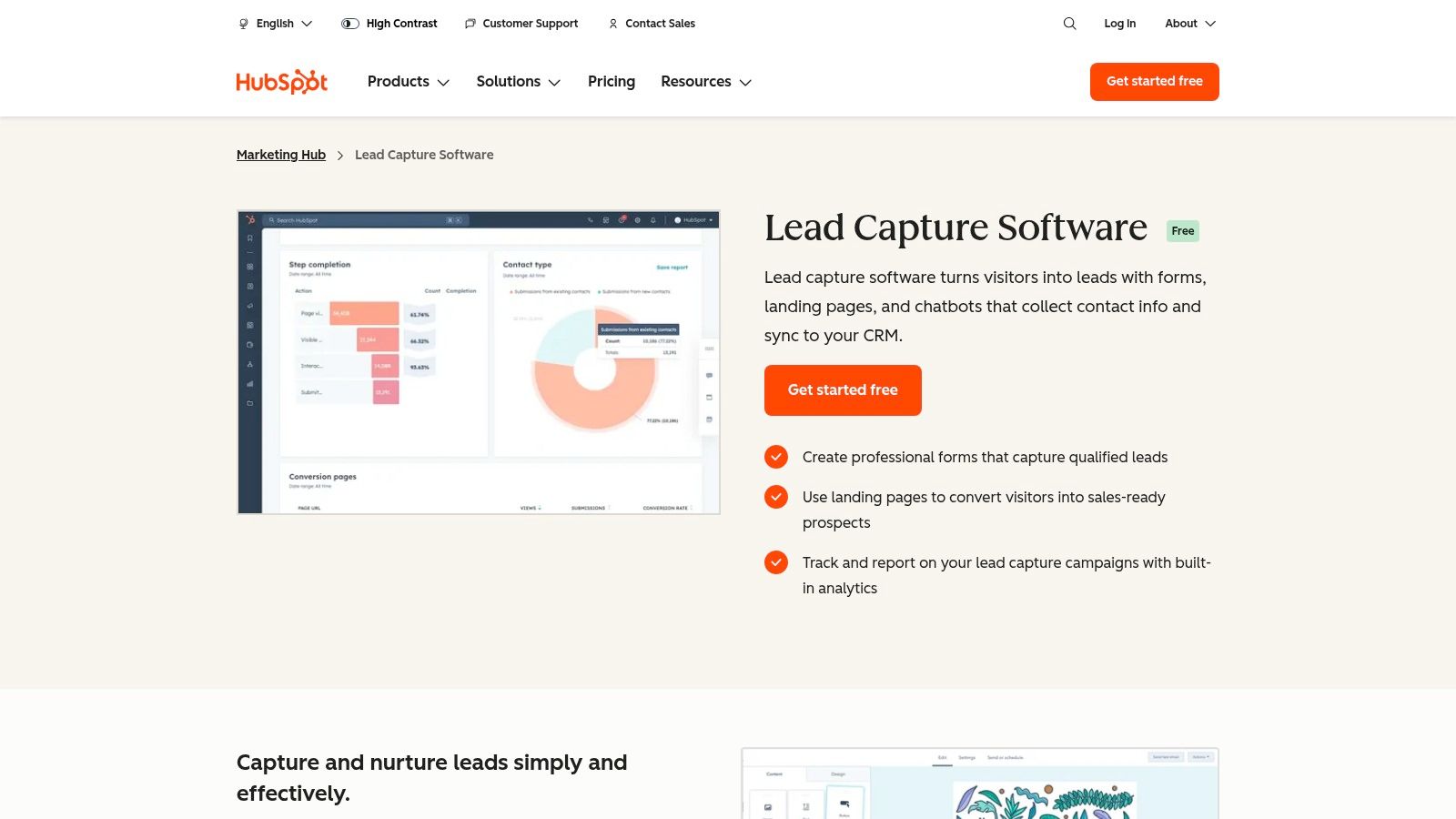
It stands out as one of the best lead generation tools because it scales from a generous free plan to sophisticated enterprise tiers. Startups and small businesses can immediately begin capturing leads using free forms, pop-ups, and live chat. As they grow, they can upgrade to unlock advanced automation, AI-powered campaign optimization, and detailed analytics, ensuring the platform evolves with their needs.
Key Features & Considerations
- Integrated Toolset: Combines landing pages, forms, email marketing, and chatbots directly with the HubSpot CRM.
- Scalable Pricing: Offers a robust free tier, with paid plans (Starter, Professional, Enterprise) that increase in price based on features and contact list size.
- Implementation: The user interface is clean and intuitive, supported by extensive documentation and the HubSpot Academy. However, higher-tier plans often require a one-time onboarding fee for guided setup.
This ecosystem approach allows you to not only generate leads but also nurture them effectively within the same platform. The primary limitation is cost; the platform can become a significant investment as your contact database expands. For organizations committed to a centralized marketing and sales strategy, HubSpot provides a powerful, cohesive foundation.
Website: https://www.hubspot.com/products/marketing/lead-capture
2. ZoomInfo SalesOS
ZoomInfo SalesOS is a premium B2B intelligence platform specializing in accurate contact and company data, making it a powerhouse for outbound prospecting. It directly addresses the challenge of finding verified decision-maker information by providing direct-dial phone numbers, email addresses, and detailed organizational charts. For sales teams that prioritize high-volume, targeted outreach, ZoomInfo offers a deep well of actionable data.
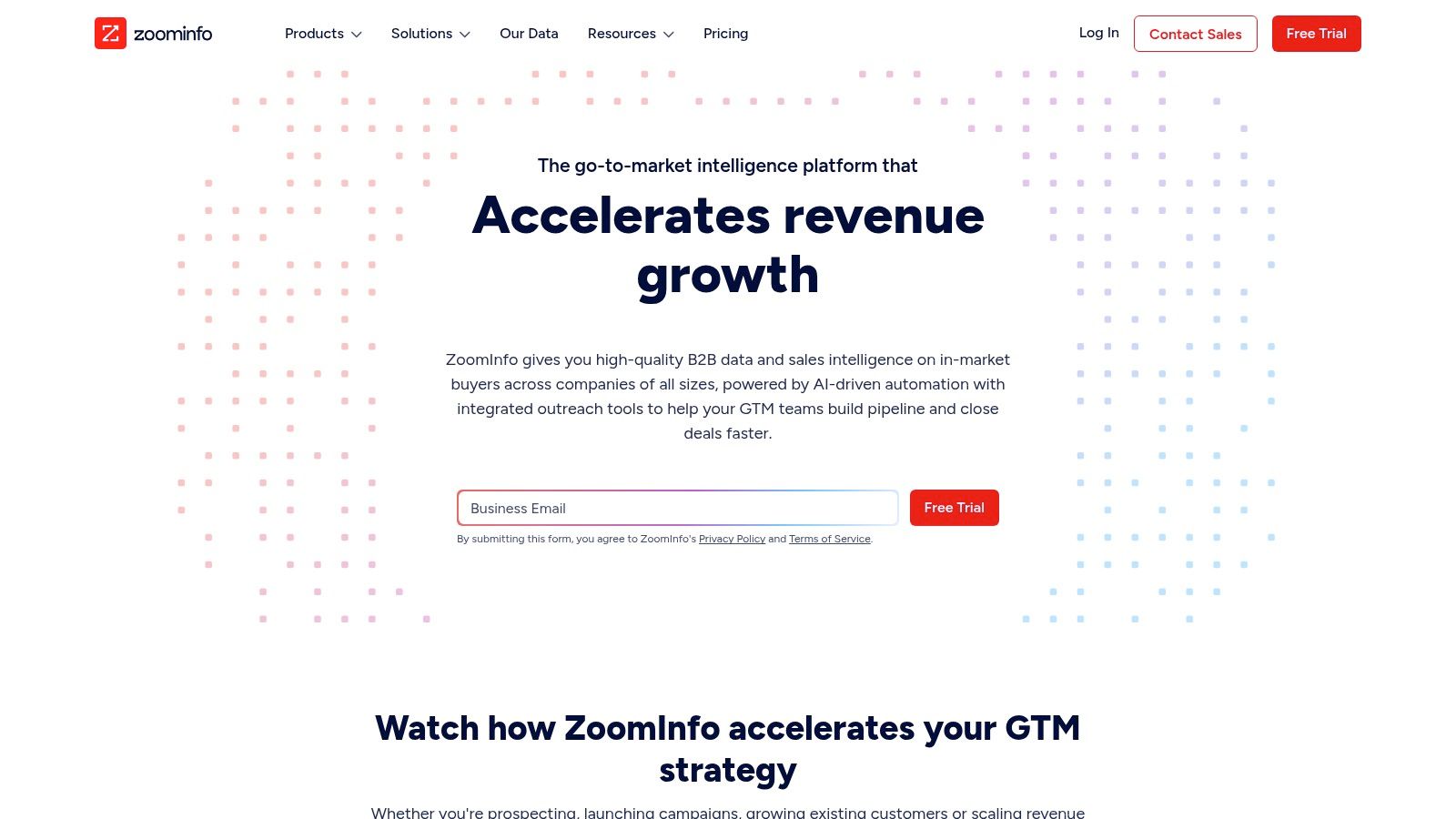
It solidifies its place as one of the best lead generation tools by layering intent data over its vast database. This allows users to identify companies actively researching solutions like theirs, turning cold outreach into warm, relevant conversations. While its primary strength is in the US market, the platform's ability to integrate directly into major CRMs and provide real-time data enrichment makes it an essential part of many B2B lead generation strategies.
Key Features & Considerations
- Robust B2B Database: Access to an extensive collection of direct dials, verified emails, technographics, and company hierarchy information.
- Opaque Pricing: Contracts are quote-based, billed annually, and can be a significant investment, making it less accessible for small teams or startups.
- Implementation: Integrates seamlessly with popular CRMs like Salesforce and HubSpot to streamline prospecting workflows. The platform itself is data-rich, which can present a learning curve for new users to maximize its potential.
ZoomInfo’s value lies in its data quality and the efficiency it brings to outbound sales motions. The main drawback is its high cost and multi-year contract structure, which can be prohibitive. For organizations with dedicated sales development teams that can leverage the data at scale, the return on investment can be substantial.
Website: https://www.zoominfo.com
3. Apollo.io
Apollo.io is an integrated B2B database and engagement platform that combines a massive lead repository with powerful outreach tools. It streamlines the entire top-of-funnel process, from finding accurate contact data to executing automated email sequences, all within a single interface. For sales and marketing teams needing both reliable data and the means to act on it, Apollo offers an exceptionally cost-effective solution.
It has earned its place as one of the best lead generation tools by democratizing access to enterprise-grade prospecting data. Where competitors often lock essential features behind high-priced contracts, Apollo provides a generous free plan and transparent, credit-based tiers. This allows startups and SMBs to build sophisticated outbound campaigns without a significant upfront investment, scaling their efforts as they achieve results.
Key Features & Considerations
- Unified Platform: Combines a vast contact database with advanced filters, intent data, email sequencing, a power dialer, and enrichment capabilities.
- Affordable Access: Offers a free-forever plan with monthly credits, while paid tiers provide more data and features at a lower price point than many alternatives.
- Implementation: The platform is self-serve with a clean user experience. It integrates directly with popular CRMs like Salesforce and HubSpot, and its browser extensions for Gmail and LinkedIn make prospecting seamless.
This all-in-one approach significantly reduces the need to purchase and manage separate tools for data, sequencing, and enrichment. The primary limitation is the credit and export caps on lower-tier plans, which require users to be strategic about their usage. For teams focused on efficient and scalable outbound lead generation, Apollo provides a powerful, unified engine.
Website: https://www.apollo.io
4. LinkedIn Sales Navigator
LinkedIn Sales Navigator is the professional network’s native prospecting solution, designed for relationship-led B2B selling. It leverages LinkedIn's unparalleled live data to help sales teams find, understand, and engage with the right people at their target accounts. By providing a dedicated interface separate from the standard LinkedIn feed, it focuses users exclusively on revenue-generating activities.
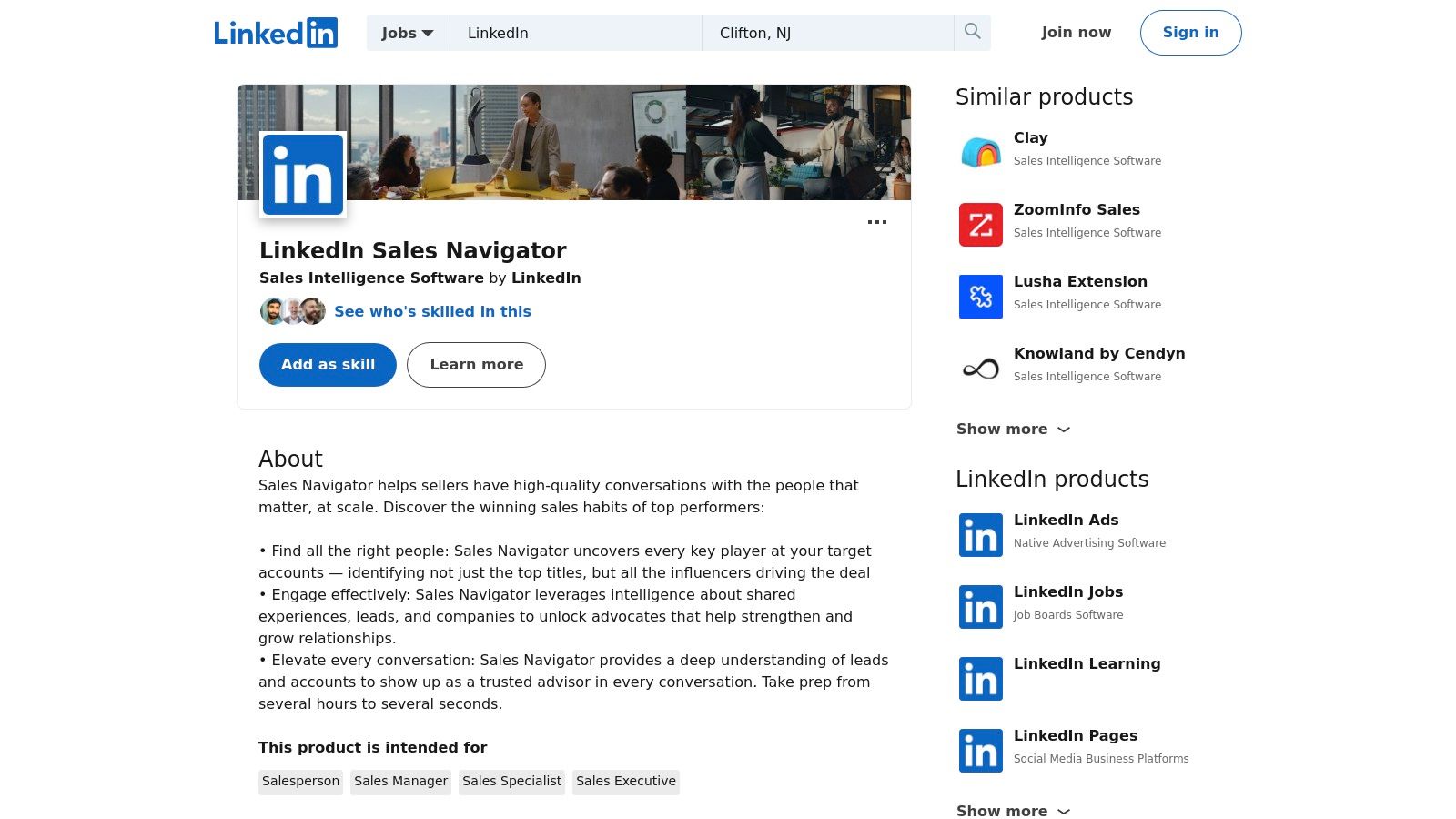
It solidifies its place among the best lead generation tools by transforming social networking into a predictable prospecting channel. Its advanced search filters allow for granular targeting based on seniority, function, company size, and more, which is crucial for building accurate prospect lists. The platform is especially powerful for account-based marketing, where understanding organizational charts and identifying key decision-makers is fundamental to success. The insights you can gather are also invaluable when you create detailed buyer personas for your campaigns.
Key Features & Considerations
- Advanced Search & Filtering: Provides access to granular search filters and real-time alerts on lead and account activities, such as job changes and company news.
- TeamLink & InMail: TeamLink reveals warm introduction paths through your company's collective network, while InMail messages allow direct outreach to prospects outside your connections.
- CRM Integration: Syncs leads, accounts, and activities with major CRM platforms like Salesforce and HubSpot, though this is typically reserved for higher-tier plans.
While Sales Navigator offers the best source of live professional data, its effectiveness hinges on active user engagement. The main limitation is that it's a closed ecosystem; success relies on prospects being active on LinkedIn, and you often need a separate tool for email and phone data to execute a true multi-channel outreach strategy.
Website: https://www.linkedin.com/products/linkedin-sales-navigator
5. Clearbit by HubSpot (Breeze Intelligence)
Clearbit by HubSpot supercharges lead generation by enriching inbound data directly within the HubSpot ecosystem. Now part of HubSpot's "Breeze Intelligence" suite, it solves the problem of long, friction-filled forms by automatically appending detailed company and contact information using just a business email address. This allows marketers to ask for less information upfront while still capturing the rich firmographic data needed for effective segmentation and lead routing.
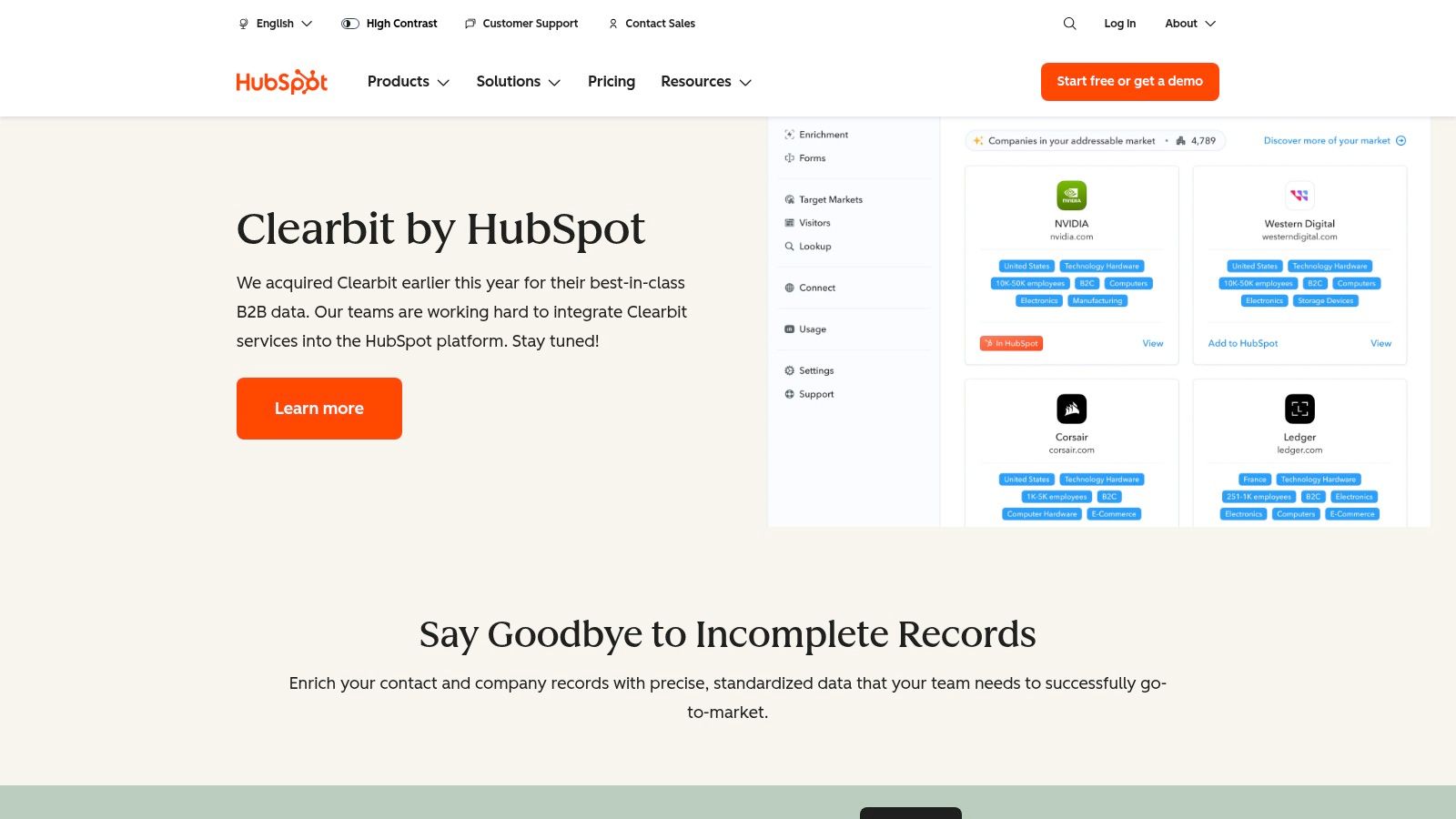
It solidifies its place among the best lead generation tools by turning anonymous website traffic into actionable B2B leads. The "Reveal" technology identifies the companies visiting your site, enabling you to tailor website content dynamically or alert sales teams for timely outreach. This seamless integration transforms the HubSpot CRM from a simple contact database into an intelligent, data-rich command center for all marketing and sales activities.
Key Features & Considerations
- Data Enrichment & Form Optimization: Automatically populates contact and company profiles with over 100 data points, allowing for shorter, higher-converting lead capture forms.
- Credit-Based Model: Usage is managed through a credit system integrated into HubSpot subscriptions. New customers must purchase credits via HubSpot, and credits reset monthly.
- Implementation: As a native HubSpot integration, setup is straightforward for existing users. However, be aware that the legacy free Clearbit tools are being discontinued in April 2025.
The primary advantage of Clearbit is its deep, native integration for HubSpot users, which enhances lead scoring, routing, and personalization efforts without complex third-party connectors. The main drawback is the shift to a HubSpot-exclusive credit model, which may be a limitation for businesses not using the HubSpot platform.
Website: https://www.hubspot.com/products/clearbit
6. Lusha
Lusha is a B2B prospecting tool designed to provide sales teams with direct contact information, such as emails and mobile numbers, for their ideal leads. It operates primarily through a browser extension, allowing reps to quickly enrich contact data directly from LinkedIn profiles or company websites. This streamlines the outbound sales process by removing the guesswork involved in finding accurate contact details.
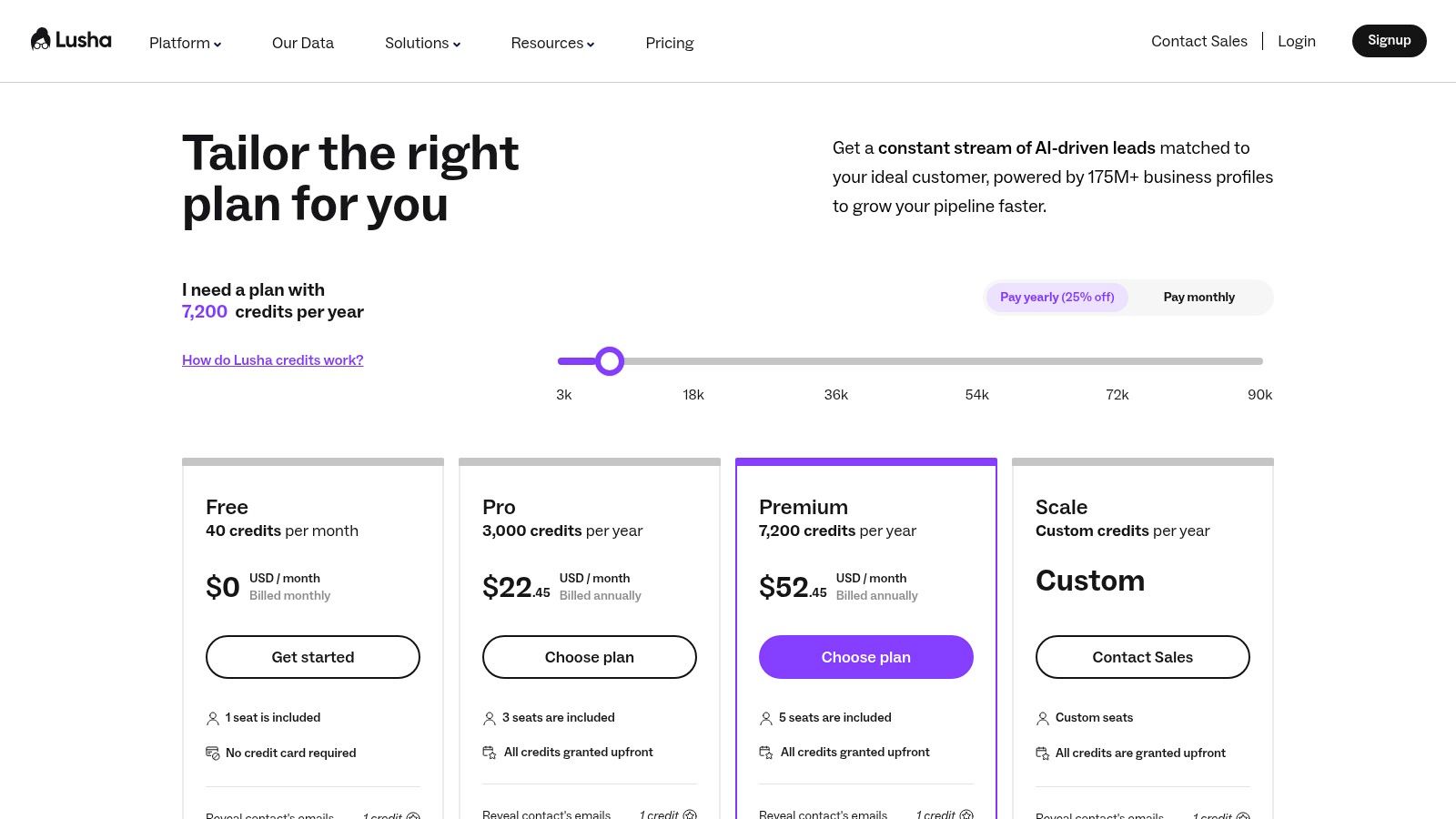
It has secured its place as one of the best lead generation tools for SMBs due to its straightforward, credit-based model and low barrier to entry. Sales professionals can install the extension and start prospecting almost immediately, integrating revealed contacts directly into their CRM. The predictable, pay-for-what-you-use pricing makes it an accessible option for teams that need high-quality data without committing to an enterprise-level platform.
Key Features & Considerations
- Credit-Based Model: Users spend credits to reveal contact information (e.g., 1 credit per email, 10 credits per phone number), with paid plans offering rollover credits.
- Generous Free Tier: Offers a free plan that includes a set number of credits per month, making it easy to test the platform's data quality and workflow.
- Browser Extension & CRM Integration: Seamlessly integrates with popular platforms like Salesforce, HubSpot, and Pipedrive, allowing reps to enrich and sync data without leaving their browser.
The primary strength of Lusha lies in its simplicity and effectiveness for individual sales reps and smaller teams. The main limitation is that credits can be consumed quickly, especially when retrieving both email and phone numbers for multiple contacts. While excellent for targeted SMB prospecting, it may be less suitable for enterprise-scale data enrichment needs.
Website: https://www.lusha.com/pricing/
7. Hunter
Hunter is a specialized lead generation tool designed for one primary purpose: finding and verifying professional email addresses. It excels in its straightforward approach, allowing sales and marketing teams to quickly build targeted email lists by searching for contacts associated with a specific company domain. This focus on email accuracy makes it an essential tool for outbound campaigns where deliverability is paramount.
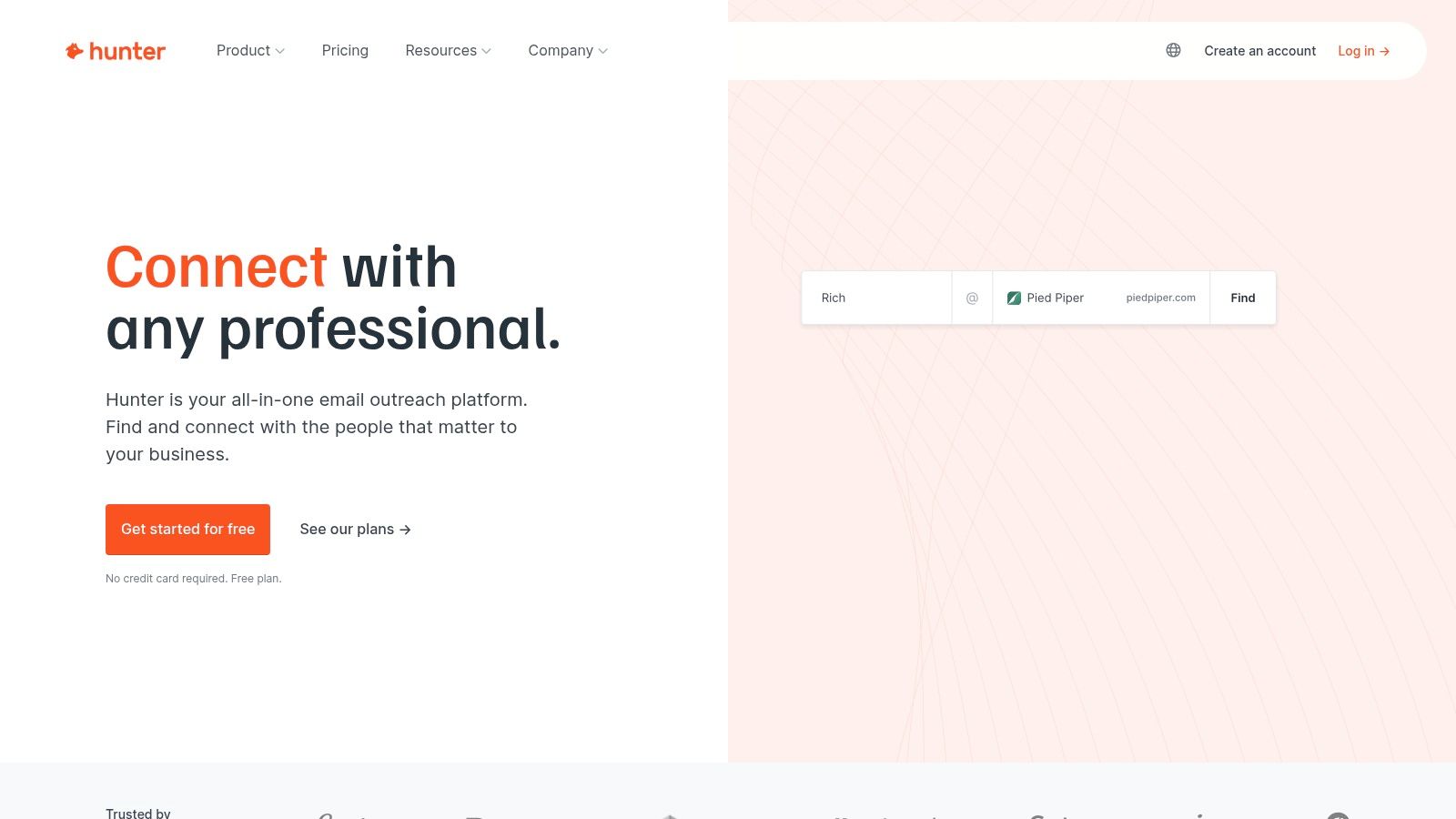
It has earned its spot as one of the best lead generation tools for its simplicity and effectiveness. Unlike complex all-in-one platforms, Hunter does one thing exceptionally well. Its transparent, credit-based pricing model offers a free plan for low-volume users and scales affordably, making it accessible for freelancers, startups, and enterprise teams alike. For anyone building a cold outreach strategy, Hunter provides the foundational data needed to start conversations.
Key Features & Considerations
- Core Functions: Includes an Email Finder for specific individuals, a Domain Search for all contacts at a company, and a robust Email Verifier to check list health.
- Affordable Pricing: Offers a free plan with monthly searches and verifications. Paid plans are based on the number of "requests" (searches or verifications) needed per month, making costs predictable.
- Implementation: The tool is web-based and incredibly easy to use, with a popular Chrome extension for finding emails while browsing websites. It also integrates directly with CRMs like Salesforce, HubSpot, and Pipedrive.
The platform's main strength is its laser focus on providing verified email data, which significantly reduces bounce rates and improves sender reputation. Its primary limitation is the lack of phone numbers or other contact data, and its built-in outreach "Campaigns" feature is very basic. Hunter is best used as a data source to fuel more sophisticated sales engagement or email marketing platforms.
Website: https://hunter.io
8. UpLead
UpLead is a powerful B2B contact database designed to provide highly accurate prospect data, including verified emails and direct-dial mobile numbers. It carves out its niche by offering enterprise-grade data quality with pricing and a credit-based model that is accessible to small and mid-sized businesses. This makes it a strong alternative to more expensive, contract-heavy platforms.
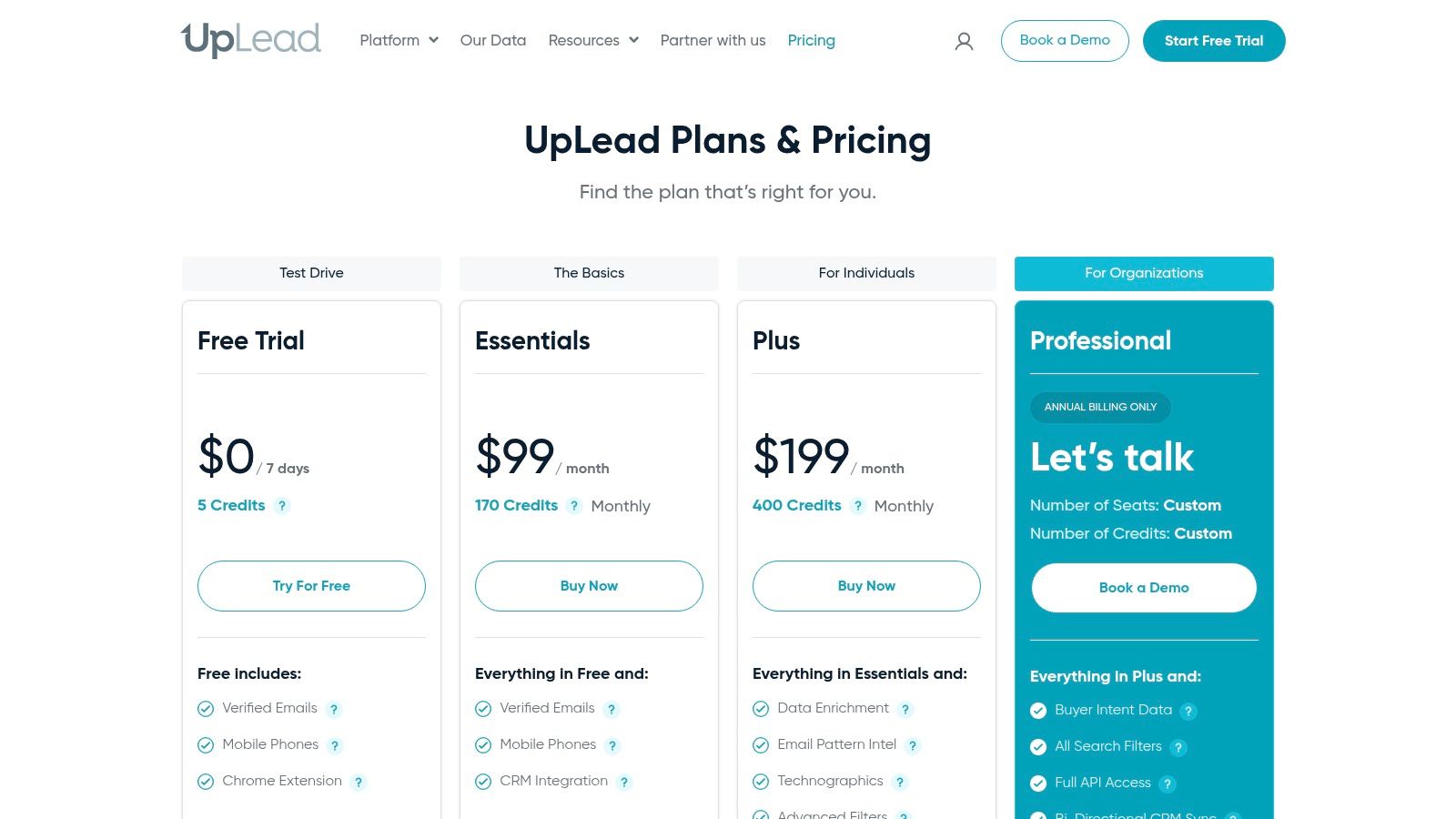
It distinguishes itself among the best lead generation tools through its real-time email verification process. When you export a contact, UpLead verifies their email on the spot, ensuring you only spend credits on deliverable addresses. This focus on data accuracy, combined with features like intent data and technographic information, allows sales and marketing teams to build targeted, high-quality prospect lists with confidence.
Key Features & Considerations
- Verified Contact Data: Provides access to a massive database of B2B contacts with a 95% data accuracy guarantee and real-time email verification.
- Credit-Based Pricing: Offers a free trial and several transparent, tiered monthly or annual plans where users pay for credits to unlock contact details.
- Direct CRM Integration: Seamlessly exports contact lists and data to popular CRMs like Salesforce, HubSpot, and Pipedrive, streamlining sales outreach.
The primary strength of UpLead is its balance of quality and cost-effectiveness, especially for companies prioritizing accurate phone numbers and emails for their outbound campaigns. Its credit system is straightforward but may become less economical for teams with extremely high-volume data needs. For businesses that require a reliable source of B2B leads without a massive upfront investment, UpLead is an excellent choice.
Website: https://www.uplead.com/pricing/
9. Dealfront (Leadfeeder)
Dealfront, widely known by its former name Leadfeeder, is a powerful B2B intelligence platform that turns anonymous website traffic into actionable sales leads. It identifies the companies visiting your site, even if they never fill out a form, allowing your sales team to engage with high-intent accounts that are already exploring your solutions. This transforms your website from a passive marketing tool into a proactive source for your pipeline.
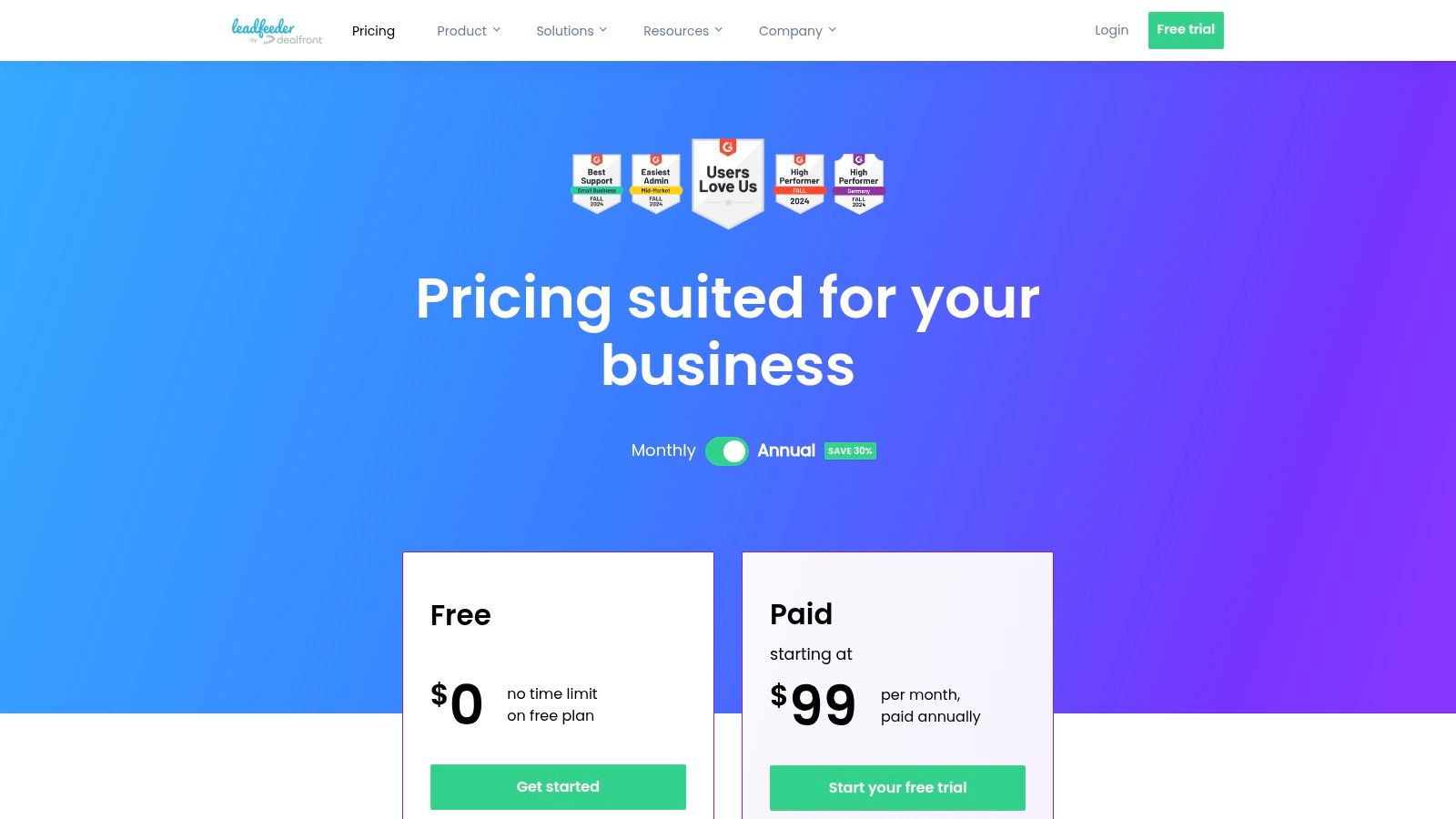
It secures its place as one of the best lead generation tools by bridging the gap between marketing efforts and sales outreach. Instead of waiting for inbound inquiries, you can identify companies showing purchase intent based on their browsing behavior, such as pages viewed and time spent on site. This data empowers sales teams to personalize their outreach, referencing the prospect's clear interest and dramatically improving connection rates.
Key Features & Considerations
- Visitor Company Identification: Tracks and reveals the company names of your anonymous site visitors, along with detailed browsing history.
- CRM Integration & Lead Scoring: Pushes identified company data directly into popular CRMs like Salesforce, Pipedrive, and HubSpot, often with lead scoring to prioritize the hottest prospects.
- Pricing Model: Offers a free "Lite" plan with limited features (7-day data retention). Paid plans are based on the number of unique companies identified per month, with unlimited users included.
The platform's primary strength is uncovering the "hidden" sales funnel of interested accounts. A key limitation is that it identifies companies, not specific individuals, so further enrichment or research is often needed to find the right contact. For B2B companies with a clear ideal customer profile, Dealfront provides an invaluable layer of intelligence to fuel account-based marketing strategies.
Website: https://www.leadfeeder.com/pricing/
10. OptinMonster
OptinMonster is a powerful on-site conversion optimization toolkit designed to convert abandoning website visitors into subscribers and customers. It specializes in advanced behavioral triggers and targeting rules, allowing businesses to display highly relevant offers to the right user at the perfect moment. This focus on intelligent, trigger-based engagement sets it apart from more basic pop-up builders.
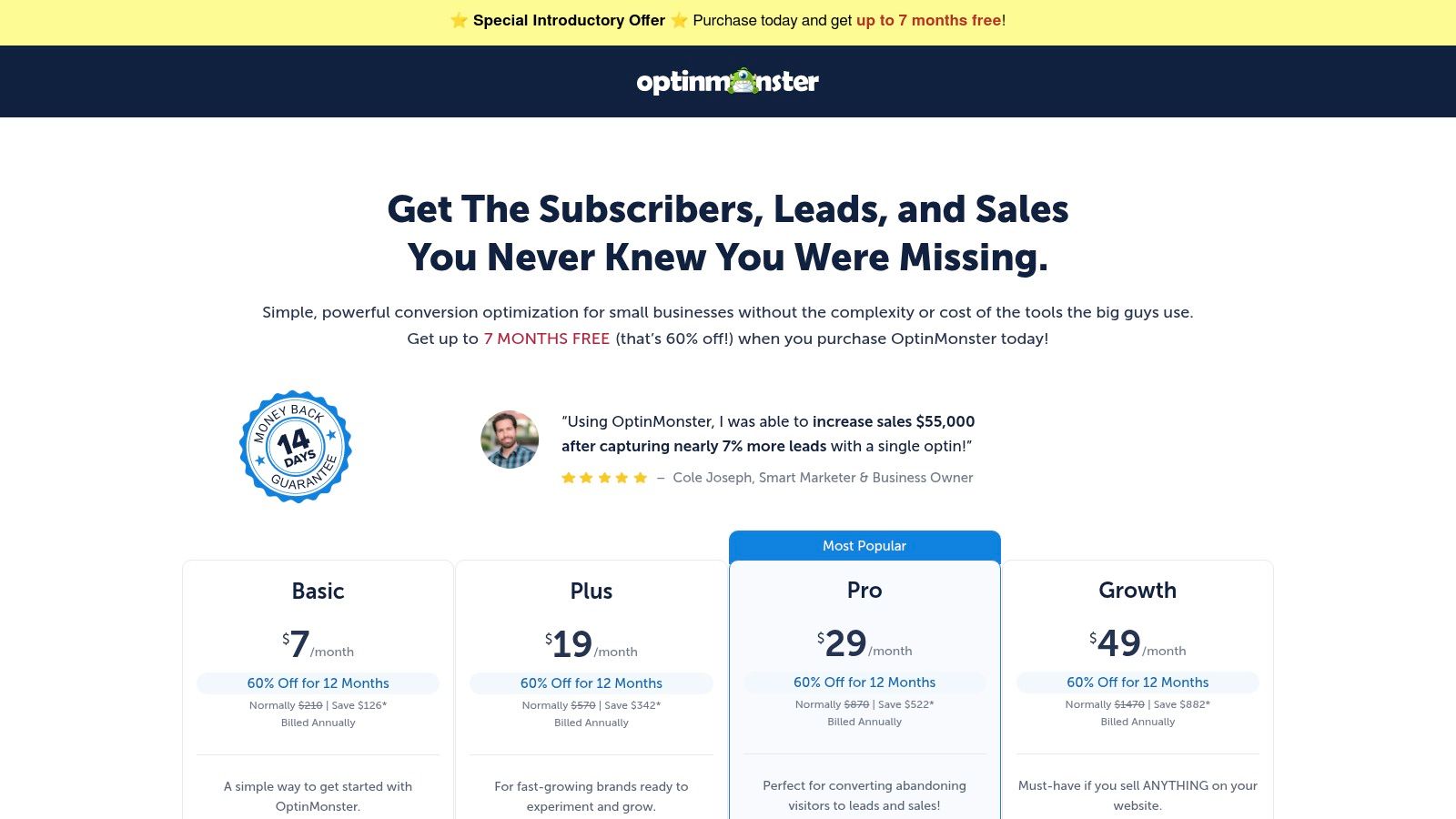
It has earned its place as one of the best lead generation tools by providing an accessible yet sophisticated way to maximize conversions from existing traffic. Its signature Exit-Intent® technology detects when a user is about to leave your site and presents a targeted campaign to capture their attention. This ability to re-engage visitors before they bounce is a game-changer for e-commerce stores and content publishers looking to grow their email lists and reduce cart abandonment.
Key Features & Considerations
- Advanced Targeting Rules: Features Exit-Intent® technology, scroll triggers, geolocation, and device-based targeting to create highly personalized campaigns.
- Pricing and Plans: Offers several tiers (Basic, Plus, Pro, Growth) with pricing based on pageviews, number of sites, and feature access. There is no free plan, but a 14-day money-back guarantee is available.
- Implementation: Provides seamless integration with WordPress and other major CMS and e-commerce platforms. The drag-and-drop builder and extensive template library make campaign creation straightforward for non-technical users.
OptinMonster excels at turning website traffic into actionable leads through intelligent pop-ups, floating bars, and gamified wheels. While its pageview limits on lower-tier plans can be a constraint for high-traffic sites, it remains a cost-effective solution for businesses serious about on-site conversion rate optimization.
Website: https://optinmonster.com/pricing/
11. G2 - Lead Generation Software Category
G2 is not a direct lead generation tool but rather an essential starting point for your research. It’s a comprehensive software marketplace that leverages thousands of verified user reviews to help you compare and vet potential solutions. This peer-to-peer insight is invaluable for cutting through marketing hype and understanding how a platform performs in a real-world business environment.
This platform earns its spot among the best lead generation tools because it provides unparalleled transparency. It breaks down the vast lead gen landscape into specific sub-categories like visitor identification, lead capture, and scoring. By using its detailed filters and comparison Grids, you can quickly create a shortlist of vendors that fit your specific budget, company size, and integration needs, saving countless hours of manual research.
Key Features & Considerations
- Verified User Reviews: Access a massive database of peer reviews, often with detailed feedback on data accuracy, ease of use, and customer support quality.
- Categorization and Filtering: Narrow down options by feature set, market segment, and user satisfaction ratings to find the perfect fit.
- Comparison Grids: Visually compare top vendors side-by-side based on user satisfaction and market presence, which helps in making a data-driven decision.
The primary strength of G2 is its ability to offer an unbiased, crowd-sourced perspective that you won't find on a vendor's website. The main consideration is to be mindful of sponsored placements, which can influence visibility. It’s wise to look beyond the top-listed results and use the filters to uncover hidden gems that might be a better match for your business.
Website: https://www.g2.com/categories/lead-generation
12. Capterra - Lead Generation Software Category
Capterra's Lead Generation Software category serves as a comprehensive discovery platform rather than a single tool. It provides a structured directory where businesses can research, compare, and read verified user reviews for hundreds of different lead generation solutions. This makes it an essential starting point for any organization trying to navigate the crowded martech landscape and create a shortlist of potential vendors.
It earns its place as one of the best resources for finding lead generation tools by offering powerful, easy-to-use filters. Users can quickly narrow the vast selection based on specific features, pricing models, business size, and necessary integrations. This allows you to move from broad exploration to a focused comparison of relevant options, ensuring you find a tool that precisely matches your technical and budgetary requirements.
Key Features & Considerations
- Advanced Filtering: Narrows down options by essential criteria like visitor identification, pop-up builders, or specific CRM integrations.
- Verified User Reviews: The platform's transparent verification process provides authentic user feedback to validate vendor claims.
- Side-by-Side Comparison: Users can select multiple tools and compare their features, pricing, and ratings in a clear, standardized format.
While Capterra is invaluable for initial research and validation, its primary function is that of a directory. The user must still vet each tool independently. The key is to use the filters strategically to avoid getting lost in a sea of options, many of which may be broader CRM platforms rather than specialized lead generation software.
Website: https://www.capterra.com/lead-generation-software/
Top 12 Lead Generation Tools Comparison
| Product | Core Features & USP ✨ | User Experience & Quality ★★★★☆ | Value Proposition 💰 | Target Audience 👥 | Price & Plans 💰 |
|---|---|---|---|---|---|
| HubSpot Marketing Hub | Integrated lead capture + CRM + AI tools ✨ | Easy start, robust docs, scalable ★★★★☆ | Combines capture, nurture, CRM in one 💰 | SMBs to enterprises 👥 | Freemium to Enterprise; can get pricey 💰 |
| ZoomInfo SalesOS | Large US B2B DB + intent data + dialers ✨ | Deep US data, solid enrichment ★★★★☆ | Consolidates sales tools; premium value 💰 | Sales teams, enterprises 👥 | Quote-based; often costly 💰 |
| Apollo.io | Prospect DB + sequences + dialer ✨ | Intuitive all-in-one, startup-friendly ★★★★ | Affordable with transparent credits 💰 | Startups & SMBs 👥 | Free plan + tiered credits 💰 |
| LinkedIn Sales Navigator | Social graph + advanced search + InMail ✨ | Best professional data, global ★★★★☆ | Ideal for social & ABM selling 💰 | B2B sales pros, account marketers 👥 | Subscription tiers; mid-high 💰 |
| Clearbit (HubSpot Breeze) | Form shortening + enrichment + Reveal ✨ | Seamless HubSpot integration ★★★★ | Enhances marketing ops for HubSpot users 💰 | HubSpot users, marketers 👥 | Credit-based; tied to HubSpot 💰 |
| Lusha | Contact reveal emails & phones + extension ✨ | Easy browser use, predictable pricing ★★★ | Pay-for-usage, SMB focused 💰 | SMB sales reps 👥 | Generous free + pay-as-you-go 💰 |
| Hunter | Email finder + verification + outreach ✨ | Simple, strong email verification ★★★★ | Affordable & focused on email leads 💰 | Email marketers, SMBs 👥 | Clear monthly credit tiers 💰 |
| UpLead | Verified contacts + intent + mobile dials ✨ | Accurate US data, transparent pricing ★★★★ | Budget-friendly alternative 💰 | SMBs seeking accuracy 👥 | Credit-based with trial 💰 |
| Dealfront (Leadfeeder) | Visitor ID + intent data + CRM sync ✨ | Effective anon traffic lead gen ★★★★ | Transparent volume pricing 💰 | B2B marketers, sales teams 👥 | Free plan + paid volume tiers 💰 |
| OptinMonster | Pop-ups + targeting + A/B testing ✨ | Strong toolkit for ecommerce ★★★★ | Cost-effective lead capture 💰 | Ecommerce, content sites 👥 | Tiered pageview caps 💰 |
| G2 - Lead Generation Category | User reviews + vendor grids + comparisons ✨ | Rich peer feedback, US-focused ★★★★☆ | Helps shortlist and vet tools 💰 | Buyers & researchers 👥 | Free access 💰 |
| Capterra - Lead Generation | Buyer guides + reviews + detailed filters ✨ | Trusted directory with detailed analysis ★★★ | Good for early discovery 💰 | Buyers & researchers 👥 | Free access 💰 |
Choosing Your Growth Engine: Final Thoughts on Selecting the Right Tools
Navigating the landscape of lead generation software can feel overwhelming. We've explored a comprehensive suite of tools, from all-in-one platforms like HubSpot Marketing Hub to specialized outbound powerhouses like Apollo.io and ZoomInfo SalesOS. The key takeaway is that there is no single "best" tool; there is only the best tool for your specific business needs, goals, and budget.
Your selection process should be a strategic exercise, not just a feature comparison. The tools you choose will form the core of your growth engine, directly influencing your ability to attract, engage, and convert potential customers. Making the right decision requires a clear understanding of your current processes and where the most significant gaps lie.
Synthesizing Your Strategy: From Tools to a Cohesive System
The true power of the best lead generation tools is unlocked when they work together as part of a cohesive system. A standalone tool is just a piece of software; an integrated stack is a revenue-generating machine. For instance, you might use OptinMonster to capture inbound leads on your website, enrich that data with Clearbit, and then push it directly into HubSpot for automated nurturing sequences.
Similarly, an outbound team could leverage LinkedIn Sales Navigator for initial prospecting, use Hunter or Lusha to find accurate contact information, and manage the entire outreach process within Apollo.io. The goal is to create a seamless flow of data that empowers your sales and marketing teams to act quickly and effectively, eliminating manual data entry and reducing friction in the sales cycle.
How to Choose the Right Lead Generation Tool for Your Business
To move from analysis to action, evaluate your options through the lens of your unique business context. Consider these critical factors before making a final decision:
- Primary Use Case: Are you focused on inbound marketing, outbound sales, or a hybrid model? A content-driven business in Omaha will have different needs than an e-commerce retailer. Define your primary lead source and choose a tool that excels in that area. For example, Dealfront is ideal for identifying anonymous website visitors, while ZoomInfo is built for targeted B2B prospecting.
- Team Size and Scalability: Consider your current team's technical proficiency and the tool's ability to grow with you. A startup might need a user-friendly, cost-effective solution, whereas a scaling mid-sized business should prioritize a platform that can support a growing team and more complex workflows without requiring a complete overhaul.
- Integration Capabilities: A tool's value multiplies when it connects seamlessly with your existing tech stack. Ensure your chosen software integrates natively with your CRM (like Salesforce or HubSpot), email marketing platform, and other essential systems. Poor integration creates data silos and inefficient, manual workarounds.
- Data Quality and Compliance: For tools that provide contact or company data (e.g., ZoomInfo, UpLead, Lusha), the accuracy and freshness of that information are paramount. Investigate their data verification processes and ensure they adhere to compliance standards like GDPR and CCPA to protect your business from potential legal issues.
Ultimately, selecting from the best lead generation tools is a strategic investment in your company's future. The right technology, implemented thoughtfully, will not just fill your pipeline; it will provide the crucial data and automation needed to accelerate revenue growth, improve efficiency, and gain a significant competitive advantage.
Turning a collection of powerful tools into a high-performance lead generation system requires both technical expertise and strategic foresight. At Up North Media, we specialize in building the digital infrastructure that makes this possible, from data-driven SEO strategies that attract qualified traffic to web applications that convert visitors into leads. We help you connect the dots, ensuring your technology investment delivers measurable ROI and sustainable growth.
